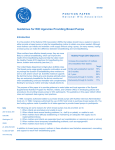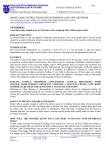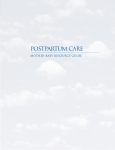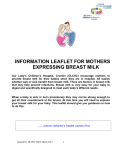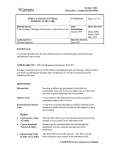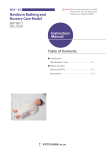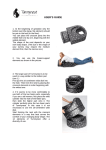Download A Doula`s Guide to the Final 6 Weeks of Pregnancy
Transcript
A Doula’s Guide to the Final 6 Weeks of Pregnancy: Taking Care of Yourself, and Preparing for Labor. Nutrition: Eating well can help to prepare your body for labor. 6 weeks before due date: make sure you’re eating a variety of healthy foods. Especially: o Iron – your baby is now storing the iron he needs for the first few months of life. Red meat and leafy greens (like spinach, some lettuces, kale) are good sources. o Your baby is also storing up vitamin D for his early months, which helps with bone development. Check your prenatal vitamin: you need 200 - 400 I.U. per day. o Protein – good for strengthening muscles. Eggs, dairy, nuts, beans, and meat. o Calcium: at least 3 servings a day. o Vitamin C helps develop healthy tissues, which is important preparation for birth. o Prenatal vitamins help to cover all the other bases. o Drink lots of fluid, at least 64 ounces a day. Water is best. In the last few days before your due date: focus on carbohydrates; these build up energy stores in your muscles. Try bread, crackers, cereal, corn, pasta, potatoes, rice, fresh fruit, and some fresh vegetables. Eat frequent, light meals. Eat some protein foods, but avoid fatty foods that are hard to digest, and spicy foods which might increase nausea in labor. Exercise: Certain exercises can help prepare your body for labor. Kegel exercises. Kegels exercise the muscles in your pelvic floor which surround your vagina and anus. This helps avoid tears and episiotomy during birth, and helps your body recover better after the birth, restoring good bladder control and sexual tone. To learn how: when you go to the bathroom, begin pee-ing, then tighten up your muscles to stop urine from flowing. Those are the muscles you want to work with. Once you’ve learned to tighten them, you shouldn’t do this while urinating… that’s just a tool to help you learn. To practice Kegels. Just tighten up the muscles, then relax. You can either do 10-20 quick repeats, with a quick tighten-release; or you can do slow “elevator” kegels, where you count slowly from 1-5, tightening your muscles a little tighter with each count, then count back down from 5-1, gradually relaxing the muscles. It’s best to do 100 kegels a day in late pregnancy. It sounds like a lot, but it’s easy to do a few at a time, off and on all day. You can do them while talking on the phone, or watching TV, or driving, or showering, or whenever. You can do this anytime, anywhere, and no one knows you’re doing it! Pelvic tilts. These strengthen your stomach muscles, which can help with back pain. They also help the baby move to an ideal position for birth. How to: Get on your hands and knees. Tighten up your stomach muscles and muscles in your bottom… this will arch your back up like an angry cat, at the same time “tuck your tail” like a scared dog. Hold for a few seconds, then relax back to a flat back (don’t let back sag down.). Repeat. At least 20 times a day. Sit crosslegged. Sit on the floor, or elsewhere, “Indian style”. This helps open up and relax your hip joints which can help during delivery; it also helps baby get in the best position. Help the Baby Move into the Best Position for Birth (can lead to shorter, less painful labor) What position is best, and why? Ideally, in labor, baby is head-down, with his back along your belly, and his face pointing toward your back. (This is called anterior.) Lots of babies (as many as 25%, or 1 in 4) are posterior instead: looking toward your belly, with his hard little head pressing against your lower back. This causes back labor, which is usually more painful than regular labor, and labor also tends to last much longer, as the baby is not in a good position to help your cervix dilate. There are suggestions later on in the booklet for how to treat back labor; however, it’s better if you can prevent having a posterior baby and back labor by trying the following methods in the last six weeks of pregnancy. What to avoid: The heaviest part of a baby is his back. By the laws of gravity, his body will rotate so the heaviest part is down, closest to the ground. If you spend the final weeks of pregnancy lying on your back, leaning back in the car, and reclining in the couch with your feet up, your back will always be lowest, and baby is more likely to be posterior. What to do: Try any of these; the more you do them, and the less you’re on your back, the better. Sleep on your side. During the day: sit up straight in chairs, sit backwards in a chair and lean your arms on the back, stand or walk for part of the day, lie belly-down on a soft beanbag chair, sit crosslegged on the floor, do pelvic tilts. Some people say the best activities are: crawling on your hands and knees, or scrubbing the floor on your hands and knees. Emotional Preparation: Fear can slow labor and increase pain; so it’s best to work out some of your fears before labor begins! Spend some time thinking about, or talking about: what part of labor are you afraid of? What’s the worst thing that could happen during labor? What scares you about birth and parenting? Draw pictures, or write it down, talk about it, or do whatever helps you explore and process these fears. Also, caring a new baby can be stressful, so try to reduce other stresses before birth. If you are struggling in your relationships with the baby’s father or with your family, work on this before the baby is born. Figure out who you can reach out to for support if you’re having a hard time with the baby; talk to them about this before the baby is born. Warning Signs in Pregnancy. Call your doctor if you see any of these signs. • Bleeding. Bleeding (especially bright red blood from your vagina) at any time during pregnancy should be reported to caregiver immediately. • Headaches, blurred vision, swelling of arms, hands, or face, pain right under your ribcage • Sudden, unexplained weight gain. • Decreased fetal movements. • Signs of Labor before 37 weeks. For example, contractions of your uterus (five or more in an hour). Menstrual-like cramps. Dull ache in your lower back. Pressure in your pelvis, groin, or thighs. Increase / change in vaginal discharge, especially a gush of fluid. When will your baby be born? Your due date is only a guess at when your baby is born. It is perfectly normal for your baby to come anytime from 2 weeks before your due date to 2 weeks after your due date. I always tell my clients and students to be ready for the baby 2 weeks before the due date, just in case; but plan on the pregnancy going 2 weeks past the due date, just in case. If your baby is “late”, try not to get too impatient. Many women are tired of being pregnant, and will hope for induction, where a doctor uses medication to make labor begin. However, all methods of induction carry risks with them: primarily longer and stronger contractions, which are a) more painful for mom, and b) harder for the baby to cope with: may lead to fetal distress and a c-section. Use the extra days to take extra care of yourself, and pamper yourself before you need to focus all your energy on caring for someone else’s needs. Signs that Labor May Begin Soon / Has Begun. Possible Signs that labor may begin in the next few days or weeks. • Backache: Not the type of backache you have in late pregnancy that changes when you shift position, but an on-going dull ache that makes you restless and irritable. • Cramps. Cramping in your belly that is mild to moderate in discomfort. • PMS symptoms: crabby, irritable. • Nesting Urge. A sudden irresistible urge to clean, or do projects to prepare for baby. • Frequent, soft bowel movements (diarrhea). Flu-like symptoms. If you have these symptoms, it doesn’t necessarily mean labor is going to start right away. It may be days or weeks before labor begins. These symptoms are just a good reminder to make sure you have everything prepared for labor and birth, and to make sure you know what other signs to be watching for. Don’t get overly excited, just continue your normal routine, get lots of rest, eat and drink well, and take care of yourself. Preliminary Signs that labor may be about to begin. • Bloody show. During pregnancy, cervix contains mucus, which may be released in late pregnancy. May be a thick ‘plug’ of pinkish mucus, which might come out when you use the toilet. May be thin, mucousy discharge on toilet paper. If there is more blood than mucus, call caregiver. (Note, it’s common to have a brownish, bloody discharge within 24 hours of a vaginal exam, or intercourse. Don’t mistake this for bloody show.) • Water breaks: o Trickle or a gush. If it’s just a little mucousy fluid, it may be mucous plug. o Pay attention to what time it breaks, write down its color, odor, etc. o Call your doctor. Usually (80% of the time), you will go into labor on your own in the next 24 hours. • Braxton-Hicks Contractions. Also called “pre-labor” or “false labor” contractions. o Some women never experience these, some women may have them for weeks before labor begins. o Pre-labor contractions don’t progress: they may be irregular, or may stay same length, strength, and frequency. May last for a short time, or for several hours. Some women even start to develop a pattern: with contractions every 6-7 minutes for 2-3 hours, which then stop again. o Discomfort is mostly felt in the front of the abdomen, as muscles tighten up. May feel like your belly is a basketball. o Contractions may stop if you walk, change position or change activity, eat, drink, or empty bladder. o ‘False Labor’ doesn’t mean they don’t hurt, and it also doesn’t mean that they’re not doing anything. Although the contractions aren’t dilating your cervix yet, they are helping you to progress in other ways: moving the cervix to an anterior position, ripening and effacing the cervix. Positive Signs of Labor. Labor has begun. • Gush of amniotic fluid from vagina. • Progressing contractions: Get longer, stronger, and/or closer together with time. Are usually described as ‘very strong’ or ‘painful’, felt in the abdomen, back, or both. May start in the back, and radiate around to front. Usually increase if you walk. • Dilation of cervix seen in vaginal exam. Early Labor What’s Happening: Cervix effaces (thins out) from 50-100%, dilates to 4 cm. Contractions 5-30 minutes apart. Contractions last 15 to 45 seconds, or longer. Mom may want to focus during contractions, but can walk or talk if desired. Can usually relax between contractions, and can carry on a conversation. Early labor can last 2-24 hours or more. Breathing techniques: No special techniques needed to cope with contractions. However, many moms find it helps to begin breathing patterns which are useful in later labor: Begin and end contractions with a deep cleansing breath, use deep abdominal breathing thru contraction. Comfort Techniques: Alternate rest and relaxation, distracting activities, and labor-enhancing activities. Being active (going for walks, dancing, shopping) can help labor to progress, but it’s important not to exhaust yourself. Try to be relaxed, and treat this as a vacation day. Start a fun project, or work on a hobby that you normally don’t have time to do. Positions: During labor, it is always better to be upright (standing or stting) than lying down. Gravity helps to bring your baby down in your pelvis: the pressure of baby’s head on your cervix can help your cervix to dilate more quickly. It’s good to be active, especially in ways that help change and shift the shape of your pelvis (like walking, climbing stairs, doing hula dance or belly dance motions.) It’s easier for your baby to rotate and descend if you’re moving. Also, try to sit in ways that help to open up your pelvis (see example on the left.) If labor is moving slowly: There’s no need to rush early labor. Try to stay calm and relaxed and take good care of yourself. If it’s night-time, try to get some rest so you have more energy for active labor in the morning. To help you rest: take a warm bath (might slow contractions a little), then lie down (lying on your left side is best). If it’s daytime, and you want to move labor along, you can be active (go for walks, etc.) or consult with caregiver about the idea of using natural augmentation such as nipple stimulation, orgasm, or acupressure. What should support people do: o Encourage mom to alternate rest, distracting activities, and labor-enhancing activities. o Encourage mom to eat, drink, and go to the bathroom at least once an hour. Good foods during labor are: bananas, nonfat yogurt, cooked cereal, eggs, graham crackers, toast, smoothies made with nonfat milk and non-acidic fruit, noodles or rice. Focus on easily digested carbohydrates. Avoid fatty foods and acidic foods. Drink as much as possible; drink mostly water and unsweetened tea, since sweet drinks can cause nausea. o Time contractions occasionally (every few hours, or when things seem to change significantly.) Time five contractions in a row, and record: when the contraction began, how long it lasted, and how long it had been since the start of the last one. Active Labor What’s Happening: Cervix completely effaced, dilates from 4-8 cm. Contractions 3-5 minutes apart, 40-70 seconds long, more painful. Active labor may last 30 minutes to 10 hours. Change in Mom’s mood: During contractions, mom is not able to walk or talk, and is focused on contraction. In between, mom wants to focus on labor, and does not want to be distracted. When to go to the hospital: Contractions are no more than five minutes apart, lasting one minute, with that pattern established for at least one hour, and mom’s mood has changed. Breathing Techniques: Deep abdominal breathing for as much of the contraction as is comfortable. Over the peak of the contraction, use hee-hee breathing or hee-hee-blow. Positions. Again, any position that’s upright; any hip swaying movement is good. Also, almost all women like to lean forward during labor: this helps take the weight of baby off of your back. Any of the positions shown above, or any of these can be helpful for reducing pain. Comfort Techniques for Active Labor: Warm bath. Touch: Massage, Effleurage (light stroking on belly), Counterpressure for back pain (support person places the palm of his hand on her lower back and provides firm pressure during contractions), Double Hip Squeeze. Hot/Cold: Heating Pads on back or belly, Ice Packs, cool cloths on her forehead and back of neck. Making noise: Singing, Moaning. Sensory Distraction: Music, Aromatherapy, Pictures. Relaxation Techniques: Touch Relaxation, Visualization, Encouragement and Support. What should support people do? Remind mom to drink after each contraction, and go to the bathroom once an hour. Help with Comfort Techniques. Establish Rituals by doing the same thing on each contraction, for as long as that works, then switching to new ritual. Let her rest when she needs to, but remind her that being physically active can help labor progress. Try to phrase things as positive suggestions, not criticisms. Back Labor (Can begin at any stage of labor.) Signs: The most common sign is back pain: during contractions the mom complains that she’s having a lot of pain in her lower back. Another very important sign to look for is contractions that “couple”: there will be two or three contractions very close together, then there’s a long pause with no contractions, then two or three contractions clustered together. Why is it a problem: Usually, it’s a sign that the baby is posterior (see discussion about baby’s position, on page 2 of this booklet). Generally, labor is more painful, it takes much longer to fully dilate to 10 cm, and pushing can be slower and more difficult with a posterior baby. What can support people do to help “fix” the problem: As soon as I see any signs of coupling contractions or back pain, I try the following techniques right away. The mom gets on her hands and knees and does pelvic tilt exercises (see description on first page.) Or mom gets in the “open knee chest” position (see diagram just above of mom with head on pillow), and rests there, or sways her hips back and forth during contractions. Alternate between pelvic tilts and open knee chest for 25-30 minutes. When mom returns to a more upright position, often the baby will move into a better position, and the signs of back labor will fade. Transition What’s Happening: Cervix dilates to 10 cm. Contractions 2-3 minutes apart, 60-90 seconds long. Intense. Mom may be discouraged, scared, angry. May be trembling, hot/cold, nauseous. How long will it last? 10 minutes to 2.5 hours. Average is 1-1.5 hours in first time moms. Breathing Techniques: Hee-hee breathing or hee-hee-blow. Counted hee-hee-blow, where partner tells mom how many hee-hees to do before each blow. Partners breathe with her. Comfort Techniques: Any of the techniques and positions from active labor. Follow her cues. What should support people do? Stay very close to mom, establish eye contact. Give short and simple directions, don’t ask a lot of questions. Speak calmly. This is the most intense part of labor for many moms, and mom needs lots of support and reassurance! Second Stage: Birth What’s Happening: Cervix has dilated, baby has descended and is ready to be delivered. Contractions continue, 3-5 minutes apart, lasting 45-90 seconds. Contractions may be accompanied by a strong urge to push. (May feel like a need to have a bowel movement.) Mom’s vocalizations may change to deep grunts or groans. How long will it last? Anywhere from a few minutes to three hours. Typically 1-2 hours. When should mom start pushing? Check with nurse or doctor before starting to bear down. Breathing Techniques and Bearing Down: Caregivers will guide you. But generally: With each contraction, take in a deep breath, then bear down for five to seven seconds, while exhaling or gently holding breath. Then relax briefly, take in a quick breath. Then bear down again. Bear down three or four times during each contraction. In between contractions, take nice deep breaths and rest. Comfort: Any of the ideas above. A cold cloth on her forehead or neck is especially popular. What should partners do: Help support mom in chosen position. Help guide pushing efforts and breathing. Lots of encouragement and reassurance. Reinforce caregivers’ suggestions. Third Stage / Newborn Procedures Immediately after birth, they may place the baby up on mom’s belly, or may take it over to a warming table, depending on the condition of the baby and on hospital policy. The doctor will deliver the placenta: you may need to do a few more light pushes. Then the doctor will examine your perineum, and will repair any tears or episiotomy. Hospital policies vary regarding immediate newborn care, but most hospitals in the Seattle area will attempt to leave the baby in its parents’ arms for as much of the first hour as possible, to allow for initial bonding, and the first breastfeeding. At the end of one hour, some mandatory procedures are done with the infant, including antibiotic eye ointment, and a Vitamin K shot. Typically, the baby is also weighed and measured at this time, and may be given its first bath. Postpartum Recovery. Lochia: You will have vaginal bleeding for two to six weeks after the birth. The early days are similar to a very heavy menstrual period, though you may see large clots of blood. It will taper off to a lighter flow, the color will become browner, or pink. Sexuality: Most doctors recommend waiting six weeks after birth, or until lochia stops, for resuming vaginal intercourse. This allows your perineum to heal after birth. Remember that ovulation may resume shortly after birth, and you will be fertile two weeks before your first period, so it is important to use birth control if you are not prepared for a possible pregnancy. Care of the perineum: You may experience soreness after the birth, especially when going to the bathroom. Try to drink a lot of water, as this will dilute your urine, and it will sting less when you pee. After urinating, use a spray bottle (they will give this to you at the hospital) to wash off your genitals with warm water, then gently pat dry with toilet paper. Postpartum Warning Signs: If you see these in the first month, call your doctor. • • • • • • • Passage of a blood clot larger than a lemon. Heavy bleeding: soaks a maxi pad in an hour. Fever of 100.4 or higher. Problems with urination: Burning, or blood in urine, inability to urinate. Very foul or fish-like odor to vaginal discharge. Increased pain at site of episiotomy or tear. Swollen, red, hot, painful area on the leg, especially the calf. Sore, reddened, hot, painful area on breast, along with fever or flu-like symptoms. Signs of postpartum depression: It is normal to experience ‘baby blues’ in the first month or so: you may find yourself often crying for no reason. This is the influence of hormones, and will soon resolve. However, if you have a history of depression (in yourself or your family) or if there are a lot of difficulties in your current life situation, you may be more at risk for postpartum depression. Share this list of symptoms with a support person, so they can help keep an eye out for them. If 3 weeks of more after the birth, you are: not able to sleep well (even when baby is sleeping), crying a lot, unable to concentrate, feeling guilt and inadequacy, disinterested in baby or hyperconcerned about baby, worrying about harming self or baby, or having headaches, chest pains, you may be developing PPD. Contact a counselor, or Depression after Delivery. Newborn Warning Signs: If you see these in the first month, call baby’s doctor. • Diarrhea: unusually frequent and very watery stools; blood or mucus in stools • Failure to urinate every six to eight hours, or fewer than five wet diapers in 24 hours (after day 4 or 5, when mother’s milk has come in) • Dehydration: if you pinch the baby’s skin, it stays pinched up; wrinkled, crepe paper-like • • • • • • • • • skin; dry mouth; dark yellow urine; sunken fontanel Fever higher than 100.4 degrees F, rectally, or above 99.5 degrees F, axillary (under arm.) Jaundice: whites of the eyes are turning yellow; skin below the nipple line turning yellow White patches on the tongue or inside the mouth Umbilical cord problems; Any redness around the cord, foul odor or pus, bright red bleeding that makes a quarter-sized spot on a teeshirt or diaper. Circumcision issues: bright red bleeding, swelling, foul discharge, unable to urinate Vomiting: forcefully or more frequently than usual (more than spitting up). Feeding problems: repeatedly refuses feedings for more than 6 to 8 hours excessively or uncharacteristically fussy or irritable; unusually lethargic or sleepy Problems with breathing: signs such as blue lips, struggling to breathe, flaring nostrils, or deep indentations of the chest when breathing. Breastfeeding Hints: • Good positions: cradle hold, football hold, side-lying. (See www.breastfeeding.com for illustrations). Make sure: baby’s chest is lying flat against your chest; baby’s body is aligned: ears line up with shoulders and hips; baby’s chin and nose are up against breast. • Signs of a good latch: look – baby shouldn’t be just latched on to the nipple, but has some of the areola in his mouth, lips are flanged out (“fish lips”); listen – don’t hear smacking or clicking noises, should hear swallowing (after day 5 when mature milk has come in); feel – may hurt for first minute or so. Should not hurt continuously. • Hunger cues: rooting, tongue thrusting, sucking. Full cues: falls asleep, pulls away from breast (if he’s been nursing less than five minutes, he’s not full, and needs to be woken up or returned to the breast, but if it’s been a long nursing, this shows he has had enough.) • Feed on demand: anytime baby shows hunger cues. At least every three hours, more is OK (even every hour or hour-and-a-half.) Should feed at least 10 minutes on first breast, then as long as desired on second breast. Next feeding, start on the other side. • • • Nipple care: After each nursing, dry off nipple, then express a little breast milk and rub it in to the nipple. Leave nipples exposed to fresh air for a few minutes before closing bra (whenever possible). Don’t use soap to clean nipples, just use clean water. For sore nipples: Follow the nipple care recommendations religiously. Nurse more often, but for a shorter time each nursing. Use labor breathing techniques to cope with pain. Help for engorgement: Take a hot shower or lay warm washcloths on your breasts for a few minutes to relieve soreness and hardness. Nurse baby more often, for shorter periods. Seattle area resources Breastfeeding Support / Lactation consultants • La Leche League - information and support for breastfeeding women. Monthly group meetings and phone counseling. (206)522-1336. www.lalecheleague.org • Childbirth Education Association of Seattle’s Breastfeeding Hotline. (206) 615-8078 • Listings for lots of local resources: www.metrokc.gov/health/breastfeeding • Most hospitals have lactation consultants available, call your hospital for information. • You can also contact your local Public Health office. General Information and Referrals • Children’s Hospital Resource Line, for basic health information: (206)526-2500 • Crisis Line: 24 hour phone support and info for any personal/family crisis. (206)461-3222 • Family Help Line: Referral to support groups and crisis line (between 9 am - 11 pm) 1-800932-HOPE (4673) or (206)233-0139 • Public Health Department - home visits by nurses, mother/infant groups, medical clinic, family planning, Medicaid and WIC program. (206)296-4786 • Family Resource Guide. www.pepsgroup.org/familyresources/default.htm Education and Support for New Parents • PEPS – Program for Early Parent Support. Neighborhood support groups for new parents: begin when babies are under 4 months, and meet once a week for 4 months. Also has dropin groups for families of children up to age 3. (206)547-8570 www.pepsgroup.org • Family Support Centers (located throughout Seattle area): offer support groups, referral, recreational activities for parents/children, classes on parenting, child care, and health screening. Most activities are free. Go to www.parenttrust.org or call Family Help Line. This doula guide was written by Janelle Durham, MSW, CD, CCE. 2003.











